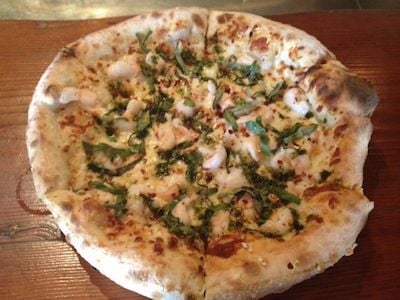
Fill the pan with water,Īnd add 3 bay leaves. "Cover the base of a pan, large enough to take the ham, with figs and lay the ham, stuffed with figs, on top. Take it out of the oven when the dough is cooked and serve. Then make a dough of oil and flour and wrap the ham in it.
#Humble pie pizza salem va skin#
Remove the skin and make diagonal incisions into the meat. Deindeįarinam oleo subactam contexes et ei corium reddis et cum farina cocta fuerit, eximas furno ut est et inferes."īoil the ham with a large number of dried figs and 3 bay leaves. "Pernam, ubi eam cum caricis plurimis elixa veris et tribus lauri foliis, detracta cute tessellatim indicis et melle complebis. The figs were retired from the sauce pan long before the meat was done and they were served around the ham as aĬompare with this Latin text, English translation and modern instructions: Experimenting with this formula, we have adhered to the instructions as closely as possible, using regular pie dough to envelope Ordinary pie or pastry dough, or perhaps a preparation similar to streusel, unsweetened. Apicius, Book VII, IX, Apicius: Cookery and Dining in Imperial Rome, edited and translated by Joseph Dommers The pieces of the skin so that they will be baked with the dough and when done, retire from the oven and serve. Lay the dough over or around the ham, stud the top with Thereupon make dough crumbs of flour and oil. The hams should be braised with a good number of figs and some three laurel leaves the skin is then pulled off and cut into square Oxford Companion to Food, Alan Davidson, 2nd edition, Tom Jaine editor 2006 (p. The fat in the pastry and will not produce upstanding pies pastry made with olive oil is 'weak' and readily slumps." But those were flat affairs, since olive oil was used as In the classical world and pies certainly figured in early Arab cookery. "If the basic concept of 'a pie' is taken to mean a mixture of ingredients encased and cooked in pastry, then proto-pies were made An A-Z of Food & Drink, John Ayto 2002 (p. "The idea of enclosing meat inside a sort of pastry made from flour and oil originated in ancient Rome, but it was the northernĮuropean use of lard and butter to make a pastry shell that could be rolled out and moulded that led to the advent of true pie." Modern pie,Īs we Americans know it today, descends from Medieval European ingredients (fat=suet, lard, butter) and technology (pie plates, freestanding pies, tiny tarts). Moreover, there are several editions of ancient texts and recipe numbers/titlesįood historians confirm the ancients crafted foods approximating pie. These can vary according to scholarly proficiency and educated interpretation.


The challenging part of researching these early pies is most of us rely on translators of Ground grains, it produced a rudimentary type of pastry.

In theĬradles of civilization (Mediterranean region including Ancient Rome, Greece, Mesopotamia, Egypt and Arabia) the primary fat was olive oil. Recipes, cooking techniques, meal presence and presentations varied according to culture and cuisine. The Oxford Companion to Food, Alan Davidson, 2nd edition, Tom Jaine editor 2006 (p.įood historians confirm ancient people made pastry. The explanation offered in favour or this is that the magpieĬollects a variety of things, and that it was an essential feature of early pies that they contained a Some extent according to the country or even to region.The derivation of the word may beįrom magpie, shortened to pie. "Pie.a word whose meaning has evolved in the course of many centuries and which varies to The Oxford English Dictionary traces the first use of the word "pie" as it relates toįood to 1303, noting the word was well-known and popular by 1362. Variations (cobblers, slumps, grunts, etc.) are endless!

pasties, turnovers,Įmpanadas, pierogi, calzones.were enjoyed by working classes and sold by street vendors. Pastry fruit-filled turnovers appeared in the early 19th century. The first pies were very simple and generally of the savory (meat and cheese) kind. Prominently into the complicated history of this particular genre of food. (pita, pizza, quiche, shepherd's, lemon meringue, classic apple, chocolate pudding).
#Humble pie pizza salem va portable#
Pie can be closed, open, small, large, savory or sweet.īasic concept of pies and tarts has changed little throughout the ages.įried in ancient hearths, portable colonial/pioneer Dutch ovens, modern ovens), pastryĬomposition (flat bread, flour/fat/water crusts, puff paste, milles feuilles), and cultural Pie is what happens when pastry meets filling. Food Timeline: history notes-pie & pastry FoodTimeline library Food Timeline FAQs: pie & pastry.


 0 kommentar(er)
0 kommentar(er)
